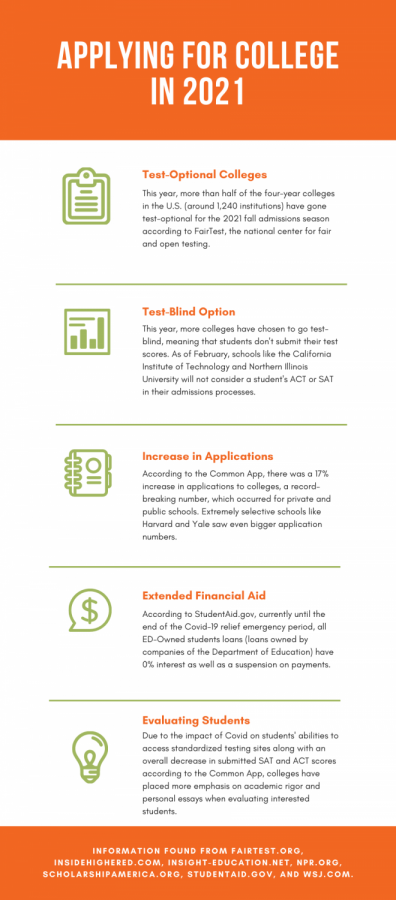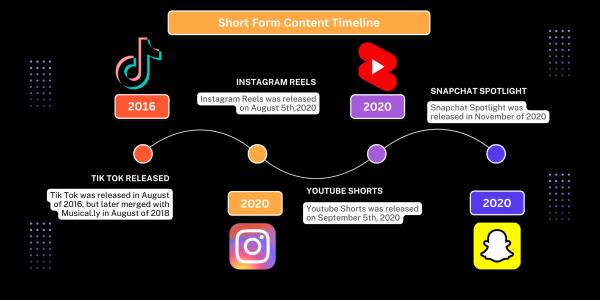“We Regret To Inform You”: College Admissions Have Changed
As college acceptance rates at highly-selective schools dropped to record-low percentages this year, college counselors have noted the toll that the pandemic took on admissions for the Class of 2021. Some LHS students were disappointed with the national alterations and their results while others received admission to their top choices.
The main reason for the heightened selectivity of top colleges and large, public universities in the U.S. this year was due to an overall increase in applications submitted. For example, according to Forbes and CBS News, Columbia University decreased its acceptance rate from 6.1% to 3.7% due to a 51% increase in applications received.
In a typical year, each LHS senior submits about five applications on average. According to Amy Belstra, the College and Career Resource Center (CRC) counselor, the average increased to six applications per student this year, with a class total of 2,725 submitted applications.
Ms. Belstra explained that many students, including those at LHS, had more time to submit applications due to the pandemic.
“Seniors were able to sit at home and think, ‘Well, why not? I’ve got a little extra time on my hands. I’ll just throw my name in the hat. We’ll see what happens,’” Ms. Belstra said.
A second contributor to the application increase — particularly for top schools — was that during the pandemic, many colleges implemented test-optional policies, allowing students to choose whether or not to submit their test scores. Forbes reported that more students chose to apply to highly-selective schools because they didn’t have to submit lower test scores.
Ms. Belstra explained that the admissions offices in highly-selective schools found it more challenging to make college decisions because they couldn’t use test scores as a filter. Instead, grades and extracurriculars were more heavily weighed in this year’s admissions.
Senior Katie Stone expressed her disappointment with some colleges’ test-blind policies, which do not allow students to submit test scores for consideration in their application. Stone explained that she believes her test scores would have aided her chances for admission, especially in the University of California system.
“I also felt that because I was forced to take the SAT and worked hard junior year on the ACT that schools should’ve recognized that by allowing me to send my scores,” Stone added via email.
Ms. Belstra explained that selective but non-elite schools were able to more easily adjust to test-optional policies. For example, the University of Illinois expressed confidence to counselors in their ability to accept students based on classes and grades rather than test scores.
Although she does not support test-blind policies, Stone does believe that test-optional policies were beneficial and should be continued in future years. Fair Test, an organization that addresses the inequity of test scores, reported that more than half of colleges in the U.S. have already extended their test-optional policy programs into the fall of 2022 and for some colleges, into the foreseeable future. In addition, the College Board announced the discontinuation of SAT Subject Tests and SAT Test with Essay options in January, adding to the uncertainty of how testing will impact college admissions next year.
After President Joseph Biden’s election into office in 2020, there was also an increase in the amount of international students who applied to top colleges in the U.S., which added to the rising number of applicants, as reported by CNBC. The Common App, the application platform that most LHS students utilize, announced an 11% surge in early applications from international students.
Although only a few LHS students in the graduating class of 2020 took a gap year, there were many students nationally who deferred their enrollment for another year due to the pandemic, according to Forbes. Duke announced that 10% of the spots allotted to freshman-year applicants were already filled with students who had taken a gap year.
Changes to the application process due to Covid-19 also created complications in admissions. Senior Colin Watson, who plans to attend Indiana University in the fall, applied to Reserve Officers’ Training Corps (ROTC) programs. He explained how the interview process for his admissions was virtual, and it was more difficult to engage with the interviewer through a screen. The medical tests needed for ROTC were delayed due to the high demand for hospitals, and physical tests proved more difficult with masks on.
“It just made it a lot more confusing to me on how to apply for ROTC and changed a lot of deadlines,” Watson explained through email.
Based on current data, Ms. Belstra noticed a slight increase in the number of applicants waitlisted in college admissions this past year.
“There’s going to be some movement between now and June or even July with waitlists for some of our [LHS] seniors, and that’s going to throw a wrench into things for them,” Ms. Belstra said. “They’re going to have to figure out what they want to do.”
According to CNBC, colleges have created longer waitlists due to their uncertainty of how many admitted students will commit to their school during the pandemic. Moreover, the most selective colleges are offering spots to waitlisted students at an average rate of 7% this year instead of the typical 20%.
Watson expressed the uncertainty of his future in college because if he is removed from the waitlist and granted a spot at one of his top choices, he plans to attend one of those schools instead.
“I really wish they would let the people on waitlists know earlier because it just kinda stinks not knowing,” Watson said over email.
Despite the situation at highly-selective colleges, some less-selective schools are experiencing the opposite issue: not enough applications. There are some schools that are in need of more admits. For example, Ithaca College extended their regular application deadline for freshman and transfer students from Feb. 1 to May 1.
The main reason for this issue is financial insecurity among families during the pandemic, as reported by Forbes. This leaves some lower-income students with the inability to attend college this year, demonstrated through the 10% decrease in the number of Free Application for Federal Student Aid (FAFSA) applicants. FAFSA is the form that future or current college students use to apply for federal financial aid.
Despite these changes, Ms. Belstra explained that the LHS seniors generally performed well in college admissions. In some ways, she believes that this admissions year is the same because a “mixed bag” of student reactions exists for every admissions cycle.
As an example, senior Tyra Kuchler is attending the University of Wisconsin-Madison, which was her top choice. Kuchler chose to submit her test scores and applied to schools where she thought she would be accepted.
“I feel like it was generally normal,” Kuchler said. “Obviously I don’t really know what exactly the college process is [typically] like, of course, but it was pretty doable.”
Still others felt the effects of this year’s different admissions season.
“I would like to think lower acceptance rates affected my decisions, but we can never know for sure,” Stone commented over email. “Some schools that I had intended to be safety schools or match schools ended up putting me on the waitlist or rejected me.”







